国の重要文化財を拝んできました(愛知県名古屋市千種区姫池通 古美術風光舎名古屋店)
2022.02.08
みなさま、こんにちは。
神社好きでブログが、お参りする神社ネタばかりの私ですが、今回は浜松市にある、とあるお寺に行って参りました。
それが、とても妙なのですが、初めは「方広寺」に行くつもりでナビに設定していました。
ところが、その通りに進んでいるのに途中からナビが示す道から反れてきまして、迷ってしまいました。
でも、車の流れもあったので逆らうこともできずになんとなく進んでいきますと、違うお寺の看板が目に飛び込んできました。
「摩訶耶寺はこちら」
一瞬、はっとしました。
それは以前、「摩訶耶寺に行ってみたい」と亡き母と話していたことを思い出したからです。
「あー、ここにあったのか。」と行けず仕舞いだったことを思い出しました。
そこで一緒に行った友人に行く先を変更することを了承してもらい、摩訶耶寺をお参りすることにしました。
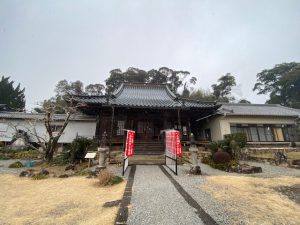
『摩訶耶寺は、神亀3年(726) 行基によって新達寺として開創されました。
富幕山に開創された新達寺は平安時代に千頭ヶ峯の観音岩と呼ばれる場所に移り名を真萱寺へと変え、やがてマカヤ寺と呼ばれるようになり、平安時代末期に一条天皇の勅願により今の場所へと移りました。
御本尊の厄除正観世音菩薩(秘仏)は奈良時代から今日まで、度重なる兵火・天災から僧たちによって守られ、受け継がれています。
摩訶耶寺は古くから厄除けの寺として知られ、袋井の法多山、祝田の善明寺の観音様と三姉妹観音で、その長女が摩訶耶寺の御本尊なのです。
庭園は平安末期から鎌倉初期の日本の中世庭園を代表するもので、座視鑑賞式池泉庭です。
不動明王像(平安時代末期の作)と千手観音像(藤原時代初期の作)は国の重要文化財に指定され、また阿弥陀如来像(平安時代末期の作)は県の重要文化財に指定されています。』
中に入りますと、お寺なのにご本尊の前に神社のお鏡がお祀りされていて驚きました。
また、ご住職のお話によると、現在の本堂は江戸時代、寛永9年(1632年)に建造され、入母屋造りで、天井には琳派の法橋関中の手による「本堂格天井図」が描かれています。
偶然にも我が家の今年のカレンダーは琳派のものですから、ときめきましたね。
2022年の気分がなんだかゴージャスな金だったので、「クリムト」か「琳派」か迷った末にこちらを選んだわけですが…。
そんなことはどうでもよくて、天井の絵がこれぞ、琳派!というもので素敵でした。
描かれているものは、当時の日本にいた動物はリアルに描かれているそうですが、ゾウなどは想像で描かれているので独特な雰囲気でして、俵屋宗達の「白象図」と似ています。
また、金の背景にボタンを一輪配する大胆な構図なども、尾形光琳の「カキツバタ図」を彷彿させます。

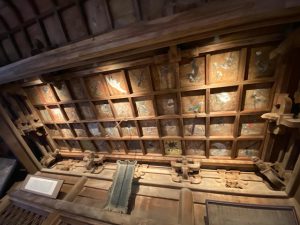
そんな歴史ある素敵な絵を、惜しげもなく写真に収めていいとは、なんとも太っ腹なお寺です。
そして、もっと太っ腹なのが、国の重要文化財である「千手観音像」(藤原時代初期の作)や、「不動明王像」(平安時代末期の作)、静岡県の重要文化財である「阿弥陀如来像」(平安時代末期の作)が展示室にございますが、そちらの目の前に座って拝むことができますし、なんと写真も収めることもできるんです。
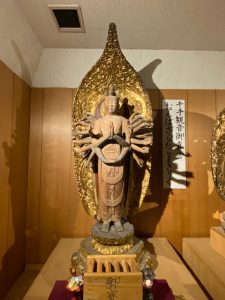
「千手観音像」(藤原時代初期の作)

「不動明王像」(平安時代末期の作)
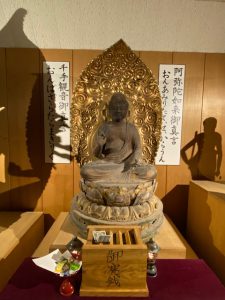
「阿弥陀如来像」(平安時代末期の作)
これらの重要文化財が昨年2021年の3月、浜松市美術館の企画展「みほとけのキセキ―遠州・三河の寺宝展―」にて公開されたようですが、浜松市美術館の企画展の中でも特に人気が高かったようで、美術館の方も驚いていたようです。
摩訶耶寺だけでなく、遠州地方や三河地方の重要文化財である仏像が一堂に会するとあっては、何としても拝みたいという方が大勢いたのでしょうね。
実は私も行こうと思っていましたが、タイミングが合わず残念に思っていた企画展でした。
そんなお話をご住職から聞きながら今日は偶然ではありますがこちらに来られてよかったなぁ、と思っていましたら、なんと、庭園も素晴らしいとのこと。
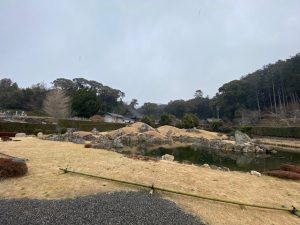
摩訶耶寺庭園は平安時代(794-1185年)末期から鎌倉時代(1185-1333年)初期に作られ、静岡県内で最も古いとされているそうです。
岩や石が巧みに組み合わせられ、壮大な自然が表現されています。
私が行った時は、浜松にしては珍しく雪が降っていたので、雪景色の中でみる庭園は特別なものがありました。
「ここは金沢かしら?」と友人に尋ねると
「金沢ならもっと絢爛豪華な感じじゃない?」と笑われました。
でも、調べてみると
『時はまだ50年前、1967年(昭和42年)に東名高速道路の工事でこの地を訪れていた日本庭園研究会?日本庭園協会?の水島信一さんが、仕事の合間に訪れたこのお寺で、泥に埋もれていたこの庭園を発見。その翌年からの調査により平安時代の作庭様式の影響が見られる庭園ということが判明。
静岡県内で最古の庭園であるだけでなく、鎌倉時代以前の古庭園が石組を含め良好な状態で残っている例としては、京都の世界遺産寺院の名園(西芳寺、天龍寺、浄瑠璃寺など)と並び日本国内でも稀有な庭園と言われます。』
とのことで、大変古くて珍しいということがわかりました。
偶然立ち寄ったお寺でしたが、とても珍しく、素晴らしいものをたくさん見せていただきました。
そして、大切なものだからと出し惜しみすることなく、「どうぞ見て行ってくださいね。」と、なんとも潔く愛にあふれたお寺だったなぁ、と思った次第でした。
静岡県の神社仏閣は割とどこでもそんな感じを受けるので、好きな県ではあります。
これからは愛知県だけでなく、足を伸ばして色々と新たなるお参りスポットを探していこうと思いました。
今日もお付き合いくださりありがとうございました。
(スタッフM)
Hello everyone.
I like shrines and my blog is all about visiting shrines, but this time I went to a certain temple in Hamamatsu city.
That is very strange, but at first I set it as a navigation system with the intention of going to “Hokoji”.
However, even though I was on that street, I got lost because I was off the road indicated by the navigation system.
However, there was a flow of cars, so I couldn’t go against it, and when I proceeded, I saw a signboard of a different temple.
“Click here for Makayaji Temple”
I was shocked for a moment.
That’s because I remembered talking to her late mother, “I want to go to Makayaji.”
I remembered that I couldn’t go and said, “Ah, was it here?”
I asked my friend who I went with to agree to change the destination, so I decided to visit Makayaji Temple.
“Makayaji Temple was founded as Shintatsuji Temple by Gyoki in the 3rd year of Kamikame (726).
Shintatsuji Temple, which was founded on Mt. Tonmaku, moved to a place called Kannoniwa in Senzugamine during the Heian period and changed its name to Shinyoji Temple. I moved to the current location by request.
From the Nara period to the present day, the Buddhist priests have been protected and inherited by monks from repeated fires and natural disasters.
Makayaji Temple has long been known as a temple to prevent evil, and is the principal image of Makayaji Temple, with Hattasan in Fukuroi, Kannon-sama and three sisters Kannon in Zenmei-ji Temple in Fukuroi.
The garden is representative of Japanese medieval gardens from the end of the Heian period to the beginning of Kamakura, and is a sitting-viewing pond garden.
The statue of Fudo Myo (made in the late Heian period) and the statue of Senju Kannon (made in the early Fujiwara period) are designated as national important cultural properties, and the statue of Amida Nyorai (made in the late Heian period) is designated as an important cultural property of the prefecture. It is specified. 』\
When I went inside, I was surprised that the mirror of the shrine was enshrined in front of the principal image even though it was a temple.
According to the chief priest, the current main hall was built in 1632 in the Edo period, and has a gabled roof. It has been.
Coincidentally, this year’s calendar at my home is from the Rinpa school, so I was thrilled.
I felt like 2022, so I chose this one after I was wondering whether it was “Klimt” or “Rinpa”.
I don’t care about that, this is the picture on the ceiling, Rinpa! It was wonderful.
It seems that the animals that were in Japan at that time are drawn realistically, but since the elephants etc. are drawn by imagination, it has a unique atmosphere, and it is called “White Elephant Figure” by Tawaraya Sotatsu. similar.
In addition, the bold composition with a single button on the gold background is reminiscent of Korin Ogata’s “Kakitsubata”.
It is a very generous temple to take a picture of such a wonderful historical painting.
And even more generous are the national important cultural properties “Senju Kannon statue” (made in the early Fujiwara period), “Fudo Myoo statue” (made in the late Heian period), and important cultural properties of Shizuoka prefecture. There is an “Amitabha statue” (made in the late Heian period) in the exhibition room, but you can sit in front of it and worship it, and you can even store photos.
It seems that these important cultural properties were exhibited at the Hamamatsu City Museum of Art’s special exhibition “Mihotoke no Kiseki-Enshu / Mikawa’s Temple Treasure Exhibition” in March 2021. It seems that it was particularly popular, and the museum was also surprised.
If not only Makayaji Temple but also Buddhist statues, which are important cultural properties of the Enshu region and Mikawa region, meet together, there must have been many people who wanted to worship at all costs.
Actually, I was thinking of going, but it was a special exhibition that I was disappointed because the timing was not right.
While listening to such a story from the priest, I thought it was a coincidence today, but I’m glad I came here, but the garden is wonderful.
The Makayaji Garden was built from the end of the Heian period (794-1185) to the beginning of the Kamakura period (1185-1333), and is said to be the oldest in Shizuoka prefecture.
The rocks and stones are skillfully combined to create a magnificent view of nature.
When I went there, it was snowing, which is unusual for Hamamatsu, so the garden I saw in the snowy landscape was special.
When I asked my friend, “Is this Kanazawa?”
I was laughed at, “Isn’t Kanazawa more gorgeous?”
But when I looked it up
“The time is still 50 years ago, the Japanese Garden Study Group who visited this place for the construction of the Tomei Expressway in 1967 (Showa 42)? Japan Garden Association? Mr. Shinichi Mizushima discovered this garden buried in mud at this temple that he visited during his work. A survey from the following year revealed that the garden was influenced by the gardening style of the Heian period.
Not only is it the oldest garden in Shizuoka prefecture, but an example of an old garden before the Kamakura period that remains in good condition, including stonework, is the famous gardens of world heritage temples in Kyoto (Saihoji, Tenryuji, Joruri). It is said to be a rare garden in Japan along with temples). 』\
It turned out that it was very old and rare.
It was a temple that I stopped by by chance, but it was very rare and showed me a lot of wonderful things.
And I didn’t spare myself because it was important, and I thought, “Please take a look.” It was a temple full of pure love.
The shrines and temples in Shizuoka prefecture are my favorite prefecture because I get that feeling everywhere.
From now on, I decided to go beyond Aichi prefecture and look for new places to visit.
Thank you for staying with us today.
(Staff M)
**********************
まだまだ寒い日が続いております、体調など壊さぬようお気をつけてお過ごしくださいませ。
生活様式の変化とともに、大切なお品を整理されている方も多いことと思われます。
ここ風光舎では、古美術品や骨董品の他にも絵画や宝石、趣味のお品など様々なジャンルのものを買受しております。
お片付けをされていて、こういうものでもいいのかしらと迷われているものでも、どうぞお気軽にご相談下さいませ。
風光舎は、出張買取も強化しております。
愛知県内はもちろん、岐阜県・三重県その他の県へも出張いたします。
どんなにご近所の方でもお伺いできますので、まずはお電話お待ちしております。
愛知県名古屋市千種区・骨董 買取
『古美術 風光舎 名古屋店』
TEL 052(734)8444
10:00-17:00 OPEN

